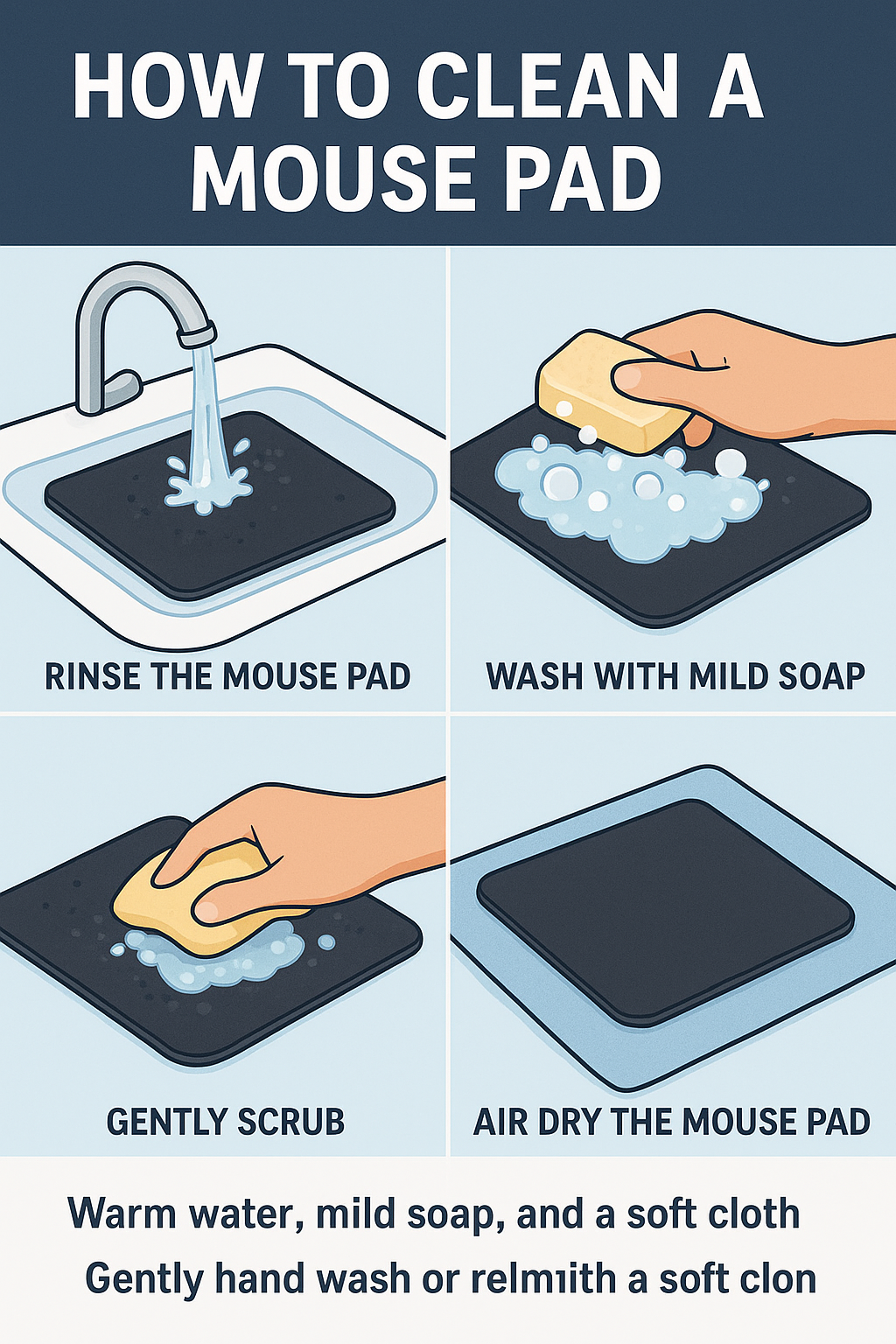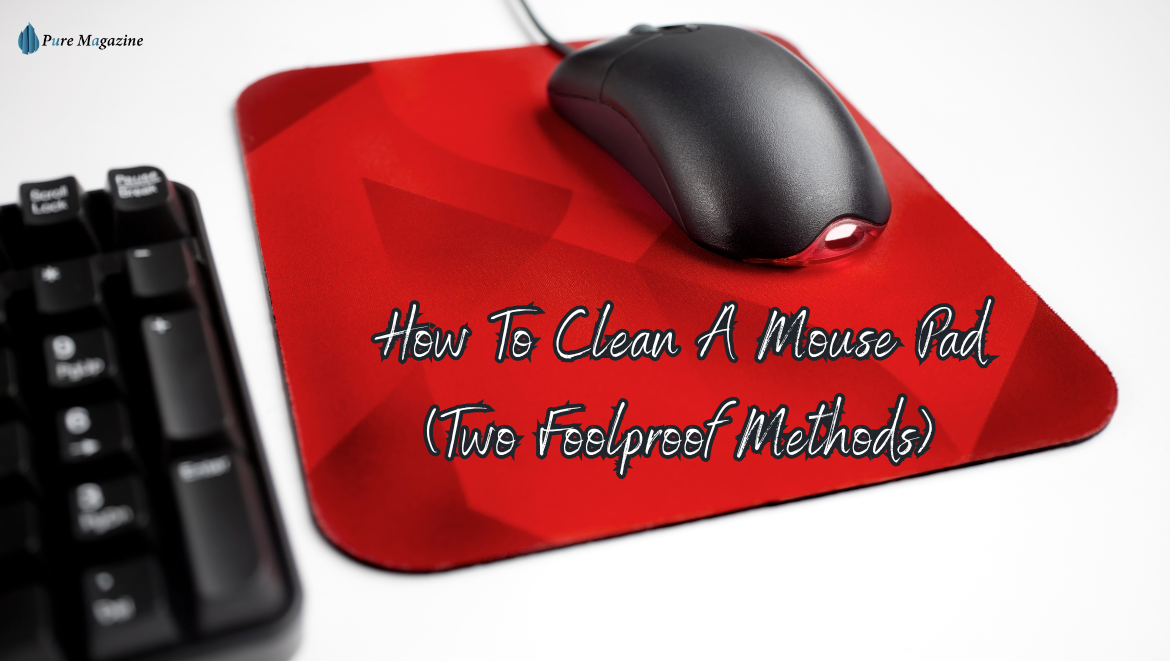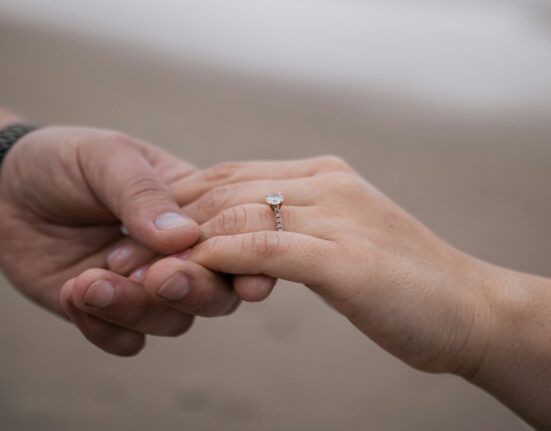Let’s be real for a second — when was the last time you actually cleaned your mouse pad? If you’re scratching your head trying to remember, you’re not alone. Most of us don’t think twice about our mousepads until they start looking like a science experiment gone wrong.
Here’s the thing: your mouse pad is basically a magnet for dead skin cells, dust, crumbs from those late-night snacking sessions, and whatever else your desk attracts. Not only is that pretty gross, but a dirty mouse pad can actually mess with your mouse’s tracking performance. Nobody wants their cursor doing the cha-cha across the screen during an important gaming match or work presentation.
The good news? Cleaning your mouse pad isn’t rocket science. Whether you’ve got a fancy RGB mousepad that lights up like a Christmas tree, a simple cloth pad, or one of those oversized gaming mats, I’ve got you covered. This guide will walk you through everything you need to know to get your mouse pad looking (and performing) like new again.
Quick Summary
To clean a mouse pad, use warm water, mild soap, and a soft cloth. Gently hand-wash it, rinse thoroughly, and air dry completely. Avoid harsh chemicals, hot water, and dryers — especially for RGB or gaming mousepads.
Signs Your Mouse Pad Desperately Needs Cleaning
You might be wondering, “Okay, but how dirty is too dirty?” Here are the telltale signs:
Visual red flags:
- Visible stains or discoloration (especially around where your wrist rests)
- Your mouse pad has changed color from its original shade
- You can see dust and debris when you lift your mouse
- That weird sticky feeling when you touch it
Performance issues:
- Your cursor skips or moves erratically
- The mouse sensor feels sluggish
- You’re noticing inconsistent tracking
According to Dr. Charles Gerba of the University of Arizona, the average desk can host up to 400 times more bacteria than a toilet seat — and yes, your mouse pad is part of that statistic.
As for how often to clean it?
If you’re a hardcore gamer or work-from-home warrior, aim for once a month. Casual users can probably get away with every 2–3 months. But honestly, if it looks or feels gross, don’t wait — just clean it.
What You’ll Need to Get Started
Good news — you probably already have everything you need.
Basic supplies:
- Mild soap or gentle dish detergent (nothing too harsh)
- Warm water
- A soft brush or clean cloth
- Clean towels for drying
- A sink, bathtub, or large basin
For stubborn stains:
- Soft-bristled toothbrush (for targeted scrubbing)
- Baking soda paste (for really tough spots)
- Gentle stain remover
What to avoid:
- Harsh chemicals or bleach
- Abrasive scrubbers
- Hot water (stick with warm or cold)
How to Clean a Mouse Pad (Two Foolproof Methods)
There are two ways to get your mouse pad looking fresh again — the safe hand-wash method and the riskier washing machine route.
Let’s start with the one that never fails.

Method 1: Hand Washing (The Safe Bet for Most Mouse Pads)
This is the tried-and-true method — gentle, effective, and safe for almost any type of pad.
Step 1: Prep Your Workspace
Fill your sink, bathtub, or basin with warm water and a few drops of mild soap. You don’t need bubbles worthy of a bubble bath — just enough to cut through the grime.
Step 2: Initial Rinse
Before dunking, give your mouse pad a quick rinse with clean water to loosen surface dirt and dust.
Step 3: Gentle Washing
Submerge your pad and let it soak for a few minutes. Then use your hands or a soft cloth to lightly scrub in circular motions. Focus on high-contact spots like where your wrist sits.
For stubborn stains, use a soft brush or toothbrush — but go easy. You’re cleaning it, not sanding it down.
Step 4: Rinse Thoroughly
Rinse under cold water until every trace of soap is gone. Leftover soap can make the surface sticky or affect tracking. Keep going until the water runs clear.
Step 5: Remove Excess Water
Press (don’t wring!) your mouse pad between two towels to soak up moisture. Think of it as a gentle squeeze, not a wrestling match.
Why hand washing wins:
- Total control over cleaning pressure
- Safe for RGB and coated gaming mousepads
- Prevents warping and fading
- Works on nearly all soft pads
Method 2: Washing Machine (Proceed with Caution)
You can clean some mousepads in the washing machine, but it’s risky.
When it’s safe:
- Cloth or fabric mouse pads only
- No RGB or electronics
- The manufacturer confirms it’s machine washable
- You’re okay with a little risk
When you should NOT:
- RGB mousepads or pads with lighting
- Hard or plastic pads
- Gel wrist rests
- Expensive or limited-edition mousepads
If you still want to try it:
- Use a gentle cycle with cold water.
- Add minimal detergent — too much leaves residue.
- Place it in a mesh laundry bag to protect it.
- Skip the fabric softener. It coats the surface and ruins tracking.
- Air dry completely — never, ever use a dryer.
Honestly? I’ve hand-washed dozens of mouse pads without issue. The washing machine might work in a pinch, but hand washing is the safer, smarter choice.
Cleaning Different Types of Mouse Pads
Cloth Mouse Pads
The easiest type to clean. Use the hand washing method and be gentle — rough scrubbing can fray edges or loosen stitching.
RGB Mousepads (Handle with Extra Care)
RGB mousepads are awesome until they need cleaning. Remember: never submerge them in water.
- Unplug first.
- Use a damp cloth with a little mild soap.
- Wipe gently, especially near ports and cables.
- Wipe again with a clean, damp cloth to remove residue.
- Air dry completely for several hours before plugging it back in.
Hard Surface Mouse Pads
The easiest to maintain — just wipe with a damp cloth and mild soap. For glass or plastic pads, a spritz of glass cleaner works too.
Mouse Pads with Wrist Rests
If it’s removable, wash the pad separately. For gel or foam wrist rests, use a damp cloth and mild soap only. Avoid squeezing — too much pressure can damage the structure.
Gaming Mouse Pads
These often have special coatings for precision tracking. Use warm water, mild soap, and a soft cloth — no harsh chemicals or heavy scrubbing. Always air dry completely before use.
How to Remove Stubborn Stains That Won’t Budge
Sometimes your mouse pad needs a little extra TLC.
General stains:
Make a baking soda paste with water, apply it to the spot, wait 10–15 minutes, then scrub gently with a soft brush.
Food and drink stains:
Blot fresh spills right away. If the stain’s older, use a drop of dish soap on a damp cloth and work it in gently.
Tough, sticky gunk:
Soak the area in warm, soapy water for 20–30 minutes before lightly scrubbing.
Pro Tip:
Skip harsh cleaners, bleach, or solvents. They might remove stains — but they’ll also damage the fabric and affect your mouse’s glide.
The Right Way to Dry Your Mouse Pad
This is where most people mess up. Drying it wrong can undo all your effort.
Best drying method:
Lay it flat on a clean towel in a well-ventilated spot. No sunlight, no dryers. Let it air dry completely — this usually takes about 24 hours.
Speed it up (safely):
- Use a fan for airflow
- Flip it halfway through
- Avoid direct heat or hanging it by the edge
Drying mistakes to avoid:
- Don’t toss it in the dryer
- Don’t use it while damp
- Don’t hang it in direct sunlight
- Don’t use a hair dryer — heat warps it
If it still feels damp, wait. A little patience beats a warped, moldy pad every time.
How to Keep Your Mouse Pad Cleaner for Longer
An ounce of prevention is worth a whole new mouse pad.
Daily habits:
- Wipe your mouse pad with a dry microfiber cloth before use
- Keep snacks and drinks off your desk (seriously)
- Wash your hands before gaming or working
Weekly habits:
- Wipe with a slightly damp cloth
- Clean your desk surface
- Vacuum around your setup to reduce dust
Bonus tip:
Use a desk mat under your mouse pad — it catches debris before it hits the surface and protects your desk too.
FAQs
Q. Can you put a mouse pad in the washer?
Yes, but only if it’s a plain cloth pad. Use cold water, a gentle cycle, and air dry completely. Hand washing is still the safer choice.
Q. Are mousepads machine washable?
Some are, but always check the label. Avoid washing RGB mousepads, hard pads, or those with wrist rests.
Q. Can you wash mouse pads with RGB lighting?
No. Only surface-clean RGB mousepads using a damp cloth and mild soap. Let them dry completely before plugging back in.
Q. How do you clean a mousepad without ruining it?
Use warm water, mild soap, and a soft cloth. Avoid heat, harsh chemicals, and dryers. Always let it air dry completely.
Q. How do you clean a mousepad without water?
Use a dry microfiber cloth or alcohol wipes for quick clean-ups. For deeper cleaning, use a barely damp cloth with soap, then wipe again with a clean one.
Q. How often should I clean my mouse pad?
Gamers or daily users: once a month. Light users: every 2–3 months. If it looks dirty or your mouse skips — clean it now.
Q. Will cleaning my mouse pad improve mouse tracking?
Absolutely. Dirt and oils interfere with sensors. A clean surface means smoother, more accurate tracking.
Wrapping It Up
Look, I get it — cleaning your mouse pad isn’t exactly thrilling. But now that you know how easy it is, there’s no reason to let it turn into a petri dish.
Whether you hand-wash or (carefully) use a washing machine, the key is being gentle, patient, and thorough. A clean mouse pad isn’t just about looks — it’s about performance, hygiene, and longevity.
So grab that mild soap, fill your sink, and show your mouse pad some love. Your cursor (and your immune system) will thank you. And hey — you might finally remember what color it was supposed to be.
Visit: Pure Magazine








